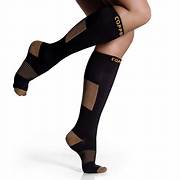Compression socks are specialized socks designed to improve blood circulation in the legs and feet by applying graduated pressure. These socks are often recommended for individuals with various medical conditions or for those who spend long hours on their feet. Here are some key points about compression socks:
Graduated Compression: Compression socks are designed with the highest level of pressure at the ankle, gradually decreasing as they move up the leg. This graduated compression helps promote blood flow from the feet back to the heart, which can reduce swelling and the risk of blood clots.
Medical Uses: Compression socks are commonly prescribed for individuals with conditions such as deep vein thrombosis (DVT), varicose veins, edema (swelling), and venous insufficiency. They can also be used during pregnancy to alleviate swelling and discomfort in the legs.
Athletic Performance: Some athletes and active individuals wear compression socks to help improve muscle recovery, reduce muscle fatigue, and enhance performance during physical activities. The compression can help with lactic acid removal and reduce muscle vibration.
Travel: Long flights or car rides can lead to leg swelling and discomfort due to prolonged sitting. Many travelers use compression socks to help maintain good blood circulation and reduce the risk of developing blood clots during travel.
Sizing: Compression socks come in various levels of compression and sizes. It’s important to consult with a healthcare professional to determine the appropriate level of compression and to ensure a proper fit. Ill-fitting compression socks may not be as effective and can be uncomfortable.
Styles: Compression socks are available in a variety of styles, including knee-high, thigh-high, and full-length stockings. They are also available in different materials and colors to suit individual preferences.
Care: Proper care of compression socks is essential for their longevity and effectiveness.
It’s important to note that compression socks should be used under the guidance of a healthcare professional, especially if they are being used for medical purposes. Consulting with a healthcare provider can help determine the appropriate level of compression and ensure that they are used correctly to address specific health concerns.
Don’t forget to send me your feedback!
BY: DANIYAL KHAN
Recommended1 recommendationPublished in apparel, Our Fashion Passion, Uncategorized




